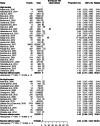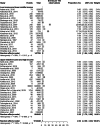Epidemiology of TB in prisoners: a metanalysis of the prevalence of active and latent TB
- PMID: 36631770
- PMCID: PMC9835258
- DOI: 10.1186/s12879-022-07961-8
Epidemiology of TB in prisoners: a metanalysis of the prevalence of active and latent TB
Abstract
Background: Tuberculosis (TB) in prisons usually occurs at higher rates than in the general population, especially in developing countries. TB has been reported as the most common cause of death among prisoners. Studies have shown limitations for early detection of TB in prisons that seem to result from mistaken concepts about TB, delayed diagnosis mainly due to the naturalization of lack of healthcare for this population METHODS: A scoping review was performed using the methodology of the Joanna Briggs Institute to assess "What are the scientific evidences on the epidemiology of TB in the prison system?". Then, a meta-analysis was performed to assess the prevalence of TB (active and latent) TB in prisoners. The results are presented as prevalence, in percentage, through random effects models, with a confidence interval of 95%.
Results: Regarding active TB, the results of the metanalysis showed that countries with a high burden of TB had a prevalence of 3.54% [2.71; 4.63], countries not considered to be high burden TB countries had a prevalence of 1.43% [0.86; 2.37]. Latent TB had a prevalence of 51.61% [39.46; 63.58] in high TB burden countries and a prevalence of 40.24% [23.51; 59.61] in countries with low TB burden. In terms of development, in low- and lower-middle-income countries, the prevalence of active TB was 3.13% [1.84; 5.29] and in high- and upper-middle income countries the prevalence was 2.25% [1.70; 2.99]. The prevalence of latent TB in high- and middle-income countries was 43.77% [28.61; 60.18] and of 49.42% [45.91; 52.94] in low and lower middle-income countries.
Conclusion: Our analysis suggests that TB, and probably other infectious diseases, find fertile ground in prisons where previous acquire social disadvantages seem to thrive-therefore, TB in prisons is a global public health problem and effective strategies are needed to control the disease are needed targeting the prison environment, including rapid health assessments to understand each context and to implement tailored and precision interventions.
Keywords: Meta-analysis; Population deprived of liberty; Prevalence; Prisoners; Prisons; Tuberculosis.
© 2023. The Author(s).
Conflict of interest statement
The authors declare that they have no competing interests.
Figures













Similar articles
-
Prevalence of latent tuberculosis infection and associated risk factors in prison in East Wollega Zone of western Ethiopia.PLoS One. 2020 May 19;15(5):e0233314. doi: 10.1371/journal.pone.0233314. eCollection 2020. PLoS One. 2020. PMID: 32428042 Free PMC article.
-
Active and latent tuberculosis among inmates in La Esperanza prison in Guaduas, Colombia.PLoS One. 2019 Jan 25;14(1):e0209895. doi: 10.1371/journal.pone.0209895. eCollection 2019. PLoS One. 2019. PMID: 30682199 Free PMC article.
-
Epidemiology and control strategies for tuberculosis in countries with the largest prison populations.Rev Soc Bras Med Trop. 2022 Nov 21;55:e00602022. doi: 10.1590/0037-8682-0060-2022. Rev Soc Bras Med Trop. 2022. PMID: 36417620 Free PMC article. Review.
-
Latent tuberculosis infection in a Malaysian prison: implications for a comprehensive integrated control program in prisons.BMC Public Health. 2014 Jan 10;14:22. doi: 10.1186/1471-2458-14-22. BMC Public Health. 2014. PMID: 24405607 Free PMC article.
-
Review of the prevalence and drug resistance of tuberculosis in prisons: a hidden epidemic.Epidemiol Infect. 2015 Apr;143(5):887-900. doi: 10.1017/S095026881400288X. Epub 2014 Nov 7. Epidemiol Infect. 2015. PMID: 25376279 Free PMC article. Review.
Cited by
-
The Challenges of Tuberculosis Management beyond Professional Competence: Insights from Tuberculosis Outbreaks among Ethiopian Immigrants in Israel.Trop Med Infect Dis. 2024 Jan 24;9(2):29. doi: 10.3390/tropicalmed9020029. Trop Med Infect Dis. 2024. PMID: 38393118 Free PMC article.
-
The American Association of Tissue Banks tissue donor screening for Mycobacterium tuberculosis-Recommended criteria and literature review.Transpl Infect Dis. 2024 Nov;26 Suppl 1(Suppl 1):e14294. doi: 10.1111/tid.14294. Epub 2024 Jun 9. Transpl Infect Dis. 2024. PMID: 38852068 Free PMC article. Review.
-
Diagnostic utility of microRNA profiles in cavitatory and non-cavitatory pulmonary tuberculosis: Research protocol.World J Exp Med. 2025 Mar 20;15(1):97460. doi: 10.5493/wjem.v15.i1.97460. eCollection 2025 Mar 20. World J Exp Med. 2025. PMID: 40115755 Free PMC article.
-
Proportion of active tuberculosis among HIV-infected children after antiretroviral therapy in Ethiopia: A systematic review and meta-analysis.PLOS Glob Public Health. 2024 Aug 2;4(8):e0003528. doi: 10.1371/journal.pgph.0003528. eCollection 2024. PLOS Glob Public Health. 2024. PMID: 39093892 Free PMC article.
-
Magnitude, associated risk factors, and trend comparisons of identified tuberculosis types among prisons in Ethiopia: A systematic review and meta-analysis.Health Sci Rep. 2024 Jan 4;7(1):e1789. doi: 10.1002/hsr2.1789. eCollection 2024 Jan. Health Sci Rep. 2024. PMID: 38186928 Free PMC article.
References
-
- World Health Organization . Global tuberculosis report 2020. Geneva: World Health Organization; 2020.
-
- Dara M, Grzemska M, Kimerling ME, Reyes H, Zagorskiy A. Guidelines for control of tuberculosis in prisons. Tuberculosis Coalition for Technical Assistance and International Committee of the Red Cross; United States; 2009.
-
- Bone A, Aerts A, Grzemska M, Kimerling M, Kluge H, Levy M, et al. Tuberculosis control in prisons: a manual for programme managers. Geneva: World Health Organization; 2000.
Publication types
MeSH terms
LinkOut - more resources
Full Text Sources
Medical

